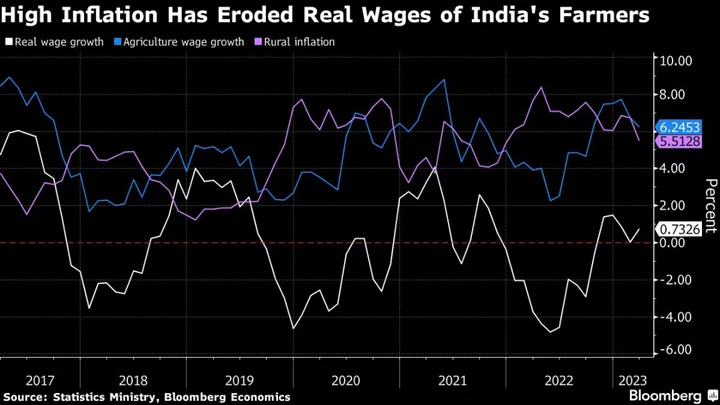Prime Minister Narendra Modi may offer handouts to Indian farmers ahead of the elections as food commodity export bans to control inflation begin to hurt incomes and could cost him some votes.
Modi’s administration banned exports of some rice varieties last month along with wheat in 2023 and imposed curbs on stockpiling some food staples with an eye to keeping inflation in check. There’s cause for a concern: ruling parties in the past have lost the national vote because they couldn’t control the price of essential items like onions.
The export bans however come with a price and is likely hit incomes in rural India where around 65% of 1.4 billion people live, a vote bank for Modi who is seeking a third term in elections next summer. Agriculture alone accounts for about 20% of the Indian economy —- one of the fastest growing in the world.
Economists say Modi needs to act sooner than later given inflation is outpacing incomes in rural areas. Farm wages grew at around 5.5% during the October-March period, according to data from Citigroup — slower than inflation averaging 6.16%.
“By initiating an export ban and imposing a stocking limit, you are strangulating the markets and imposing an implicit tax on the farmers,” said Ashok Gulati, an agriculture economist at the Indian Council for Research on International Economic Relations. The “pro-consumer and anti-farmer bias” of policies will need some intervention, he said.
The government sets a minimum support price for several crops and has increased the ceiling every year during Modi’s time in power. But limited state procurement has done little to shield farmers from selling crops at lower or even distressed prices.
“While farm input costs have come down sharply from last year, the farmers terms of trade have not improved enough due to these falling output prices,” said Samiran Chakraborty, economist with Citigroup Inc. A “rural-focused stimulus may be timed closer to the general elections,” Chakraborty said.
The government has a policy toolkit in place to support rural areas. Economists say there could be higher wages under a jobs guarantee initiative and an extension of a free grains program for 800 million people beyond December.
Farmers who own smaller plots of land are given 6,000 rupees ($72) a year for their financial needs and economists say that payout may increase. Adding benefits under a crop insurance initiative and increasing state procurement could be on the cards.
The jobs guarantee program “should be the most important policy focus in the short-term,” said Kunal Kundu, an economist with Societe Generale SA, as it provides social safety net for the most vulnerable. However, the government cut the allocation by 38% to 600 billion rupees for the current fiscal year.
Kundu said reducing taxes on fuel, and food items such as milk “would go a long way in reducing rural household stress.”
Such measures are likely to complicate government plans to keep the deficit goal at 5.9% of gross domestic product for the year ending March 2024. The fiscal gap stands at about a quarter of the target and Finance Minister Nirmala Sitharaman has tried to keep this in check by reducing subsidies and limiting unnecessary spending.
“Such dole politics will put budgets under fiscal stress, and development expenditures will suffer,” said Icrier’s Gulati. “That in turn, will adversely impact the growth story of India.”

